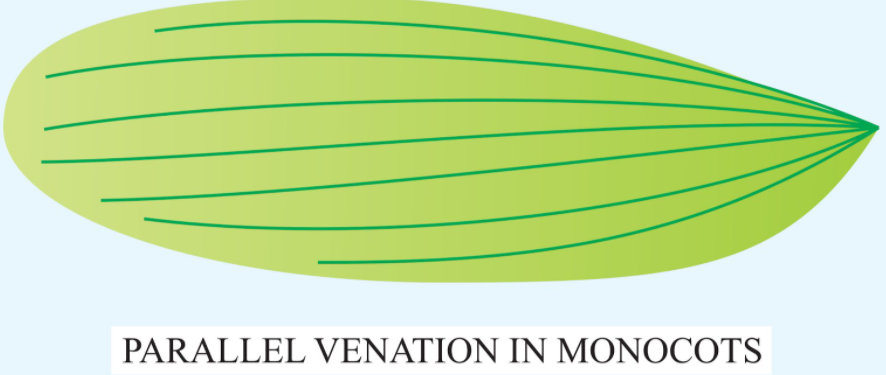
Explain the type of venation found in banana leaves.
Answer
432k+ views
Hint: It's prolonged, produce, naturally a berry which is delivered by a few kinds of enormous herbaceous blooming plants. The fruit is variable in size, color, and firmness, but is typically elongated and curved, with soft flesh rich in starch covered with a rind, which can be green, yellow, red, purple, or brown when ripe.
Complete answer:
The phenomenon of the arrangement of veins on the leaf is named venation. There are two sorts of venation, specifically reticulate venation, and parallel venation. Reticulate venation includes a sporadic appropriation of veins to shape an organization. Instances of plants indicating reticulate venation incorporate rose, tulsi, hibiscus, papaya, ficus. Parallel venation includes the veins running corresponding to each other. Instances of plants indicating parallel venation incorporate grains, banana, canna, grass, musa, Zea (maize). The leaves of monocot plants show parallel venation and the leaves of dicot plants show reticulate venation.
Parallel venation is of two types they are:
(i) Pinnately parallel venation
(ii) Palmately parallel venation.
In pinnately parallel venation there's only a single main vein called a midrib from where many small veins arise which are perpendicular to the midrib. All the small veins are parallel to each other. Example: Banana.
In palmately parallel venation numbers of veins arise from the bottom of lamina they're again divided into
(i) Palmately parallel (Divergent)
(ii) Pinnately parallel (Convergent).
In pinnately parallel (Convergent) all the veins that arise from the bottom of the lamina converge at the apex of the leaves, so-called because of the convergent type. Example: Grass
In the palmately parallel (Divergent) type, the veins ranging from the leaf base diverge or open up towards the periphery so it's called a palmately divergent type. Example: Borassus.
So the correct answer is ‘Parallel venation’.

Note:
The banana tree is a herbaceous plant with incredible and garish leaves, whose genuine stem is a bulb that grows each year.
The inflorescence offers to ascend to 'hands' for the most part shaped by 'fingers', which are the yellow fruit.
The banana belongs to the Musaceous family and therefore the Musa type. In the tropical and subtropical areas, this family is merely represented by 6 genus and 220 species, of which 50 or 60 belong to the Musa type.
Complete answer:
The phenomenon of the arrangement of veins on the leaf is named venation. There are two sorts of venation, specifically reticulate venation, and parallel venation. Reticulate venation includes a sporadic appropriation of veins to shape an organization. Instances of plants indicating reticulate venation incorporate rose, tulsi, hibiscus, papaya, ficus. Parallel venation includes the veins running corresponding to each other. Instances of plants indicating parallel venation incorporate grains, banana, canna, grass, musa, Zea (maize). The leaves of monocot plants show parallel venation and the leaves of dicot plants show reticulate venation.
Parallel venation is of two types they are:
(i) Pinnately parallel venation
(ii) Palmately parallel venation.
In pinnately parallel venation there's only a single main vein called a midrib from where many small veins arise which are perpendicular to the midrib. All the small veins are parallel to each other. Example: Banana.
In palmately parallel venation numbers of veins arise from the bottom of lamina they're again divided into
(i) Palmately parallel (Divergent)
(ii) Pinnately parallel (Convergent).
In pinnately parallel (Convergent) all the veins that arise from the bottom of the lamina converge at the apex of the leaves, so-called because of the convergent type. Example: Grass
In the palmately parallel (Divergent) type, the veins ranging from the leaf base diverge or open up towards the periphery so it's called a palmately divergent type. Example: Borassus.
So the correct answer is ‘Parallel venation’.

Note:
The banana tree is a herbaceous plant with incredible and garish leaves, whose genuine stem is a bulb that grows each year.
The inflorescence offers to ascend to 'hands' for the most part shaped by 'fingers', which are the yellow fruit.
The banana belongs to the Musaceous family and therefore the Musa type. In the tropical and subtropical areas, this family is merely represented by 6 genus and 220 species, of which 50 or 60 belong to the Musa type.
Recently Updated Pages
Master Class 11 Economics: Engaging Questions & Answers for Success

Master Class 11 Business Studies: Engaging Questions & Answers for Success

Master Class 11 Accountancy: Engaging Questions & Answers for Success

The correct geometry and hybridization for XeF4 are class 11 chemistry CBSE

Water softening by Clarks process uses ACalcium bicarbonate class 11 chemistry CBSE

With reference to graphite and diamond which of the class 11 chemistry CBSE

Trending doubts
10 examples of friction in our daily life

Difference Between Prokaryotic Cells and Eukaryotic Cells

One Metric ton is equal to kg A 10000 B 1000 C 100 class 11 physics CBSE

State and prove Bernoullis theorem class 11 physics CBSE

State the laws of reflection of light

Write down 5 differences between Ntype and Ptype s class 11 physics CBSE




